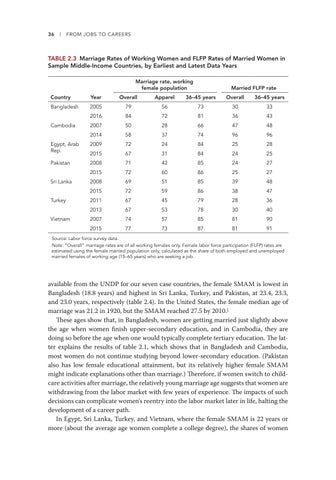36
l
FROM JOBS TO CAREERS
TABLE 2.3 Marriage Rates of Working Women and FLFP Rates of Married Women in Sample Middle-Income Countries, by Earliest and Latest Data Years Marriage rate, working female population
Married FLFP rate
Country
Year
Overall
Apparel
36–45 years
Overall
36–45 years
Bangladesh
2005
79
56
73
30
33
2016
84
72
81
36
43
Cambodia
2007
50
28
66
47
48
2014
58
37
74
96
96
Egypt, Arab Rep.
2009
72
24
84
25
28
2015
67
31
84
24
25
Pakistan
2008
71
42
85
24
27
2015
72
60
86
25
27
Sri Lanka
2008
69
51
85
39
48
2015
72
59
86
38
47
Turkey
2011
67
45
79
28
36
2013
67
53
78
30
40
Vietnam
2007
74
57
85
81
90
2015
77
73
87
81
91
Source: Labor force survey data. Note: “Overall” marriage rates are of all working females only. Female labor force participation (FLFP) rates are estimated using the female married population only, calculated as the share of both employed and unemployed married females of working age (15–65 years) who are seeking a job.
available from the UNDP for our seven case countries, the female SMAM is lowest in Bangladesh (18.8 years) and highest in Sri Lanka, Turkey, and Pakistan, at 23.4, 23.3, and 23.0 years, respectively (table 2.4). In the United States, the female median age of marriage was 21.2 in 1920, but the SMAM reached 27.5 by 2010.1 These ages show that, in Bangladesh, women are getting married just slightly above the age when women finish upper-secondary education, and in Cambodia, they are doing so before the age when one would typically complete tertiary education. The latter explains the results of table 2.1, which shows that in Bangladesh and Cambodia, most women do not continue studying beyond lower-secondary education. (Pakistan also has low female educational attainment, but its relatively higher female SMAM might indicate explanations other than marriage.) Therefore, if women switch to childcare activities after marriage, the relatively young marriage age suggests that women are withdrawing from the labor market with few years of experience. The impacts of such decisions can complicate women’s reentry into the labor market later in life, halting the development of a career path. In Egypt, Sri Lanka, Turkey, and Vietnam, where the female SMAM is 22 years or more (about the average age women complete a college degree), the shares of women


